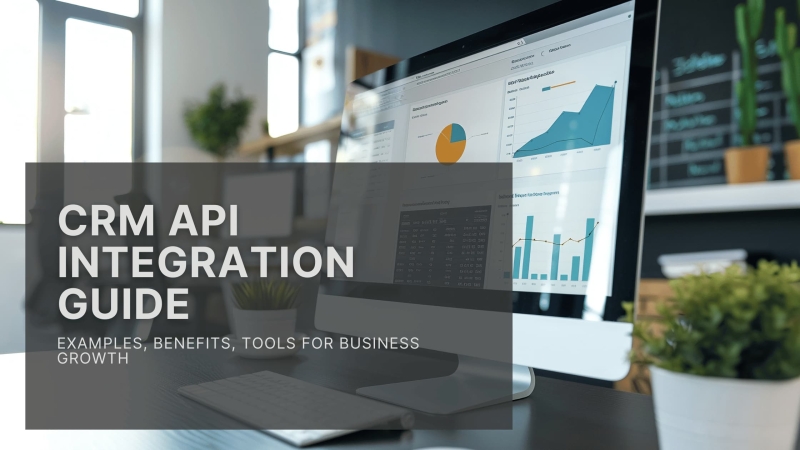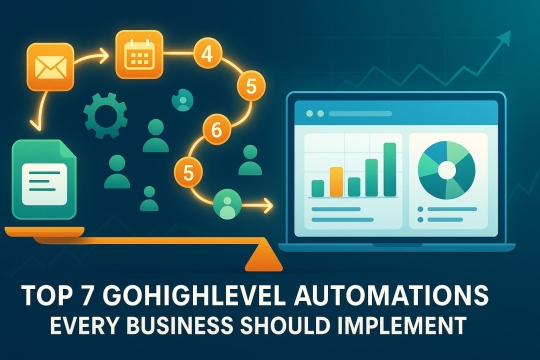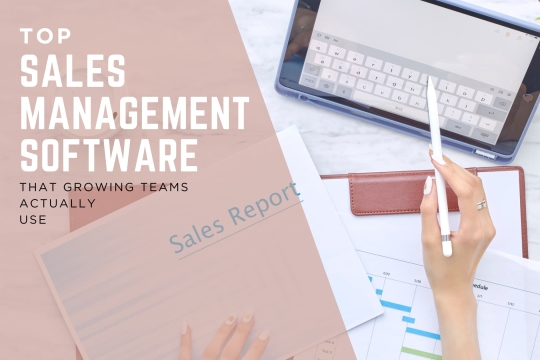CRM API Integration Guide: Examples, Benefits, Tools for Business Growth

- What is CRM API Integration?
- Why Businesses Need CRM API Integration
- Key Benefits of CRM API Integration
- CRM API Integration Examples
- How CRM API Integration Works
- Choosing the Right Tools for CRM API Integration
- Best Practices for Successful CRM API Integration
- Common Challenges and How to Overcome Them
- Conclusion
- FAQs
That’s where CRM application programming interface (API) integration comes in. By using APIs, businesses can connect a CRM with other essential tools, creating a seamless flow of information across departments. This not only improves customer interactions but also ensures that teams have access to accurate, up-to-date information when they need it most.
In this guide, we’ll break down the essentials of CRM API integration, including what it is, why it matters, practical examples of how it works, and the tools businesses can use to make integration easier. Whether you’re a small business or a growing organization, this article will help you understand how CRM API integration supports business growth and stronger customer relationships.
What is CRM API Integration?
At its core, a CRM API integration connects your CRM system with other applications through application programming interfaces (APIs). An API acts as a bridge, allowing two pieces of software to exchange data and perform actions automatically, without requiring users to switch between platforms or manually transfer information.
For example, when your CRM system is integrated with an email marketing tool, customer data can flow directly into campaigns—ensuring that the right message reaches the right contact at the right time. This removes the need for importing spreadsheets or manually entering customer details, reducing errors and saving valuable time.
There are generally two approaches to CRM integration:
- Native integrations – Built-in connections offered by the CRM vendor. These are often quick to set up but limited in scope, covering only the most common use cases.
- Custom API integrations – Developed using the CRM’s API documentation, endpoints, and authentication methods. These provide more flexibility and can connect the CRM to virtually any other platform, but they require more technical expertise and resources.
Ultimately, CRM API integration is about ensuring your business applications work together. Instead of managing disparate systems, teams can operate within a more unified system, with customer data accessible and consistent across all touchpoints.
Why Businesses Need CRM API Integration

Modern businesses rarely rely on a single platform to manage everything. Sales teams likely use CRM software to track deals, marketing teams tend to run campaigns through automation platforms, finance teams depend on billing systems, and operations often rely on project management tools. Without integration, these systems operate in silos, making it difficult to gain a complete picture of customer relationships and overall business performance.
A CRM API integration solves this by connecting the CRM system with the rest of a company’s tech stack. Instead of juggling multiple logins and transferring data manually, businesses benefit from a connected environment where information flows seamlessly. This helps teams work more efficiently, reduce errors, and deliver better customer experiences.
Key reasons businesses need CRM API integration include:
- Centralized customer relationship management
Bringing all customer data into one place ensures every department, from sales to support, has visibility into customer interactions and history. - Enhanced data accuracy
Automatic syncing between platforms reduces human error and ensures consistency across systems. - Improved customer experience
Teams can respond faster to customer issues when they have real-time, up-to-date information. - Streamlined sales and marketing processes
From capturing leads to launching targeted marketing campaigns, integrated systems allow teams to automate tasks and focus on building stronger customer relationships.
For small and mid-sized businesses, CRM integration isn’t just about efficiency—it’s a growth driver. By reducing time spent on manual tasks and eliminating barriers between systems, companies can scale operations without losing control over data quality or customer interactions.
Key Benefits of CRM API Integration
A successful CRM API integration goes beyond convenience. It can transform how businesses manage data, collaborate across teams, and deliver value to customers. Below are some of the most important benefits:
1. Unified Data Management
When businesses rely on multiple software applications without integration, data silos form. A CRM API integration eliminates these silos by ensuring customer data flows into a single, unified system. For example, linking a CRM system with billing systems or file management tools ensures every department has access to the same information, reducing errors and improving visibility.
2. Better Collaboration Across Teams
Integrating CRMs with communication and collaboration tools, such as Microsoft Teams or project management platforms, makes it easier for teams to share up-to-date information while staying aligned.
Instead of toggling between systems or relying on email threads, staff can access real-time information directly within the tools they use daily, which leads to faster responses and fewer customer issues.
3. Automation of Marketing & Sales
One of the most valuable benefits of CRM integration is automation. By connecting CRMs with marketing automation platforms, businesses can launch personalized campaigns triggered by customer interactions.
For instance, when a lead fills out a form, the CRM can automatically add the lead to a nurturing sequence, notify the sales team, and update deal stages—all without manual intervention.
4. Improved Customer Relationships
Having a full view of customer interactions strengthens customer relationships. Real-time access to up-to-date information—such as purchase history, support tickets, or open deals—allows teams to deliver more personalized service. This not only improves the customer experience but also builds trust and long-term loyalty.
- New to CRMs and don’t know where to start?
- Stuck with a broken setup that someone else botched?
- Tried the DIY route but know it’s not working the way it should?
At PointsPeak, we help businesses:
- Choose the right CRM for their needs
- Clean up and rebuild messy, underperforming setups
- Fix automation issues that cost you leads and sales
- Build scalable, conversion-focused systems that grow with you
CRM API Integration Examples
To better understand the value of CRM API integration, it helps to look at real-world scenarios where businesses connect their CRM system with other tools. These examples highlight how integration can simplify processes, improve accuracy, and strengthen customer relationships.
1. Marketing Automation + CRM
A common integration is connecting a CRM with marketing automation software. When a new lead fills out a form on a website, their details are automatically imported into the CRM. From there, the marketing tool can trigger a personalized email sequence, track engagement, and update lead scores. This ensures that sales teams focus on the most qualified leads while marketing nurtures prospects in the background.
2. File & Project Management Tools + CRM
Integrating project management or file management platforms with a CRM can help teams track deliverables and customer-related projects. For example, a consulting firm might link its CRM with a project management tool to automatically update project timelines when a deal is marked as closed. This keeps both sales and delivery teams aligned and reduces the chance of missed deadlines.
3. Billing Systems + CRM
Finance teams also benefit when billing systems are integrated with CRMs. Customer records can include invoices, payment history, and subscription details, giving sales and support staff a complete view of customer relationships. Automating invoice generation or renewal reminders reduces manual tasks while ensuring billing data remains accurate and up to date.
4. Multiple System APIs / Disparate Systems
Some businesses use a single API or middleware platform to connect multiple software applications at once. For example, integrating email, customer support, and analytics tools with the CRM allows data to flow freely across all systems. This eliminates data silos and provides decision-makers with a more unified view of customer interactions and business performance.
How CRM API Integration Works

While the benefits of CRM API integration are clear, understanding how it works can help businesses plan and implement it more effectively. At a high level, APIs provide the set of rules and protocols that allow two systems to communicate. When a CRM system offers an API, developers or middleware tools can use it to connect the CRM with other applications.
Core Components of CRM API Integration
- API Documentation & API Reference
Every CRM vendor provides API documentation that outlines available API endpoints, data formats, and usage rules. This serves as the blueprint developers use to design and manage various integrations. - Authentication Methods
Security is critical. APIs use authentication techniques like an API key or API token to verify identity and control access. This ensures only authorized systems and users can exchange sensitive customer data. - RESTful APIs and API Calls
Many CRM platforms expose RESTful APIs, which use standard HTTP methods (GET, POST, PUT, DELETE) to handle API calls. This allows different systems to interact, regardless of the programming language or platform used. - Client Libraries and Developer Resources
To simplify integration, some CRMs provide client libraries and other developer resources. These prebuilt tools help engineering teams set up connections faster without needing to code everything from scratch.
Key Considerations
When planning a CRM API integration, businesses should prioritize:
- Data accuracy – ensuring records remain consistent across all connected systems.
- Scalability – integrations should support growth as business needs expand.
- Security – safeguarding customer data from unauthorized access.
Choosing the Right Tools for CRM API Integration
Not all CRM API integrations are created equal. The right approach depends on your business needs, technical resources, and the systems you want to connect. Choosing the right tools ensures integrations are not only functional but also sustainable as your company grows.
Factors to Consider
When evaluating CRM vendors or middleware platforms, businesses should weigh several key factors:
- Business size and tech stack – Small businesses may prefer lightweight, easy-to-use solutions, while mid-sized businesses often need more advanced customization.
- Integration development complexity – Some use cases require only prebuilt connectors, while others may need custom objects or advanced workflows.
- Scalability – Can the solution handle additional tools and users as your operations expand?
- Security & compliance – Strong authentication and up-to-date information sharing are essential to protect sensitive customer data.
Popular Tools for CRM API Integration
- Zapier – Known for ease of use and a wide library of prebuilt integrations. Great for automating routine workflows without coding.
- Make (Integromat) – Offers more complex logic and multi-step workflows, ideal for businesses that need advanced automation.
- Workato – An enterprise-grade platform that connects CRMs with a broad range of business applications while offering scalability.
- Tray.io – Offers flexibility for engineering teams that need powerful automation, while also providing a visual builder.
CRM Solutions with Built-in Integrations
Many modern CRM solutions and CRM platforms now include built-in or native integrations, reducing the need for third-party tools. These options are often easier to set up but may be limited in scope compared to custom-built API connections. For example, Pulse CRM provides all-in-one functionality with built-in integrations for sales, marketing, and automation, which allows businesses to unify data and processes without relying on multiple third-party connectors.
If you’re thinking, “There’s probably a better way to do this…” — you’re probably right.
Best Practices for Successful CRM API Integration
Implementing a CRM API integration is more than just connecting systems—it requires planning and ongoing management to ensure the integration delivers long-term value. Following best practices helps businesses avoid common pitfalls and get the most out of their CRM investments.
1. Map Business Processes First
Before starting any integration development, businesses should clearly document their workflows. Understanding how data moves between departments ensures integrations are designed to support real business processes instead of creating unnecessary complexity.
2. Prioritize Data Accuracy
A CRM is only as powerful as the data it holds. Ensuring CRM data is consistent and synchronized across all systems helps teams avoid duplication, prevent customer issues, and maintain trust in reporting.
3. Use Developer Resources Wisely
For more advanced integrations, leverage the developer resources, API documentation, and client libraries provided by CRM vendors. These resources guide engineering teams through best practices for authentication, error handling, and scaling.
4. Test and Monitor Regularly
Integrations should not be treated as a set-it-and-forget-it solution. Businesses should test API endpoints, run sample workflows, and monitor logs to ensure smooth performance. Proactive monitoring reduces downtime and minimizes the risk of broken processes.
5. Plan for Scalability
As companies grow, so do their needs. An integration that works for a small team may not handle the demands of multiple departments or higher data volumes. Building with scalability in mind avoids costly rework later.
Common Challenges and How to Overcome Them
While the benefits of CRM API integration are substantial, businesses often face challenges when connecting multiple systems. Being aware of these obstacles—and knowing how to address them—can prevent disruptions and ensure smoother integrations.
1. Legacy Systems
Older or legacy systems may not support modern APIs, making integration difficult. In these cases, businesses may need to use middleware solutions or custom connectors to bridge the gap. Choosing CRM vendors that support flexible integration options can help reduce this risk.
2. Data Silos
When integrations are incomplete or poorly designed, they can create new data silos instead of eliminating them. To avoid this, businesses should carefully map out how customer data flows between platforms and ensure two-way synchronization wherever possible.
3. Disparate Systems
Companies often rely on disparate systems across departments, each with different data structures and workflows. Aligning these systems requires thorough planning and may involve creating standardized fields or using process APIs to harmonize information.
4. Customer Issues from Integration Failures
When integrations break, customers may experience delays, incorrect billing, or miscommunication. To prevent this, businesses should implement monitoring tools and alerts that quickly detect failures, allowing teams to resolve issues before they impact the customer experience.
5. Keeping Information Up to Date
Without proper synchronization, integrations can lead to outdated or incomplete records. Setting up automated updates and regularly auditing data ensures all teams work with up-to-date information, minimizing errors and improving decision-making.
Conclusion
A well-planned CRM API integration can transform the way businesses manage data, collaborate across teams, and deliver customer experiences. By connecting a CRM system with tools for marketing, sales, billing, and operations, companies eliminate data silos, reduce manual tasks, and ensure accurate, up-to-date information is always available.
For small and mid-sized businesses especially, integration is not just a technical upgrade—it’s a growth enabler. It helps teams align around shared customer data, streamline sales processes, and deliver more personalized interactions at every stage of the customer journey.
FAQs
A native integration is a built-in connection offered by a CRM vendor, designed for common use cases and typically easy to set up. An API integration, on the other hand, uses the CRM’s application programming interfaces to create custom connections. While API integrations require more technical setup, they offer greater flexibility and can connect the CRM to virtually any other tool.
APIs ensure CRM data flows automatically between systems, reducing the need for manual entry. This enhances data accuracy, maintains consistent customer records, and eliminates data silos throughout the organization.
The main risks involve unauthorized access to sensitive customer data. To mitigate this, businesses should use strong authentication methods, such as API keys or API tokens, encrypt data transfers, and follow the best practices outlined in the CRM’s API documentation.
Popular CRM solutions, such as HubSpot, Salesforce, and Zoho, offer extensive API endpoints and client libraries to support integrations. All-in-one platforms like Pulse CRM also provide built-in integrations, reducing the need for complex setups. The “easiest” choice depends on your business needs and tech stack.


